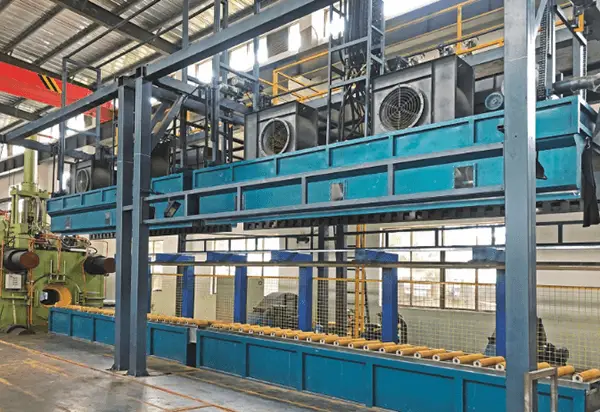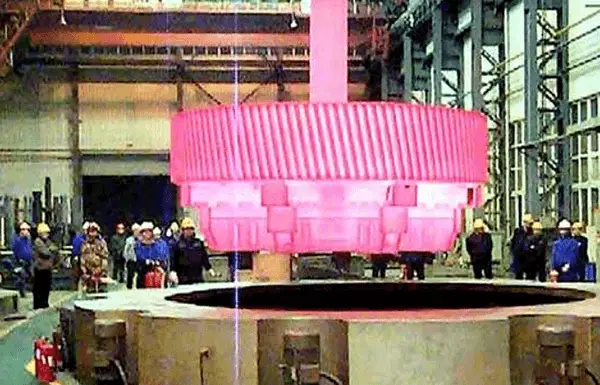In the production process, it is not uncommon for there to be insufficient hardness after quenching, which is a common defect in heat treatment and quenching.
There are two manifestations of this defect: low hardness throughout the piece and insufficient or soft spots in localized areas.
When insufficient hardness occurs, it is necessary to perform a hardness test or metallographic analysis to determine the cause, and then investigate possible contributing factors such as raw materials, heating process, cooling medium, cooling method and tempering temperature, in order to find a solution.
I. Raw material
1. Improper selection of raw materials or wrong distribution of materials
It is important to choose the appropriate material for the parts to avoid insufficient hardness or weak points. Medium carbon steel or high carbon steel should be used instead of low carbon steel, and alloy tool steel should be used instead of ordinary high carbon steel.
In example 1, using #45 steel instead of #25 steel for the gear results in a quench hardness of 60HRC compared to a hardness of 380hbs.
In example 2, it is recommended to use 9mn2v for the mold instead of T8 steel, as the quenching process to 9mn2v was mistakenly followed by oil cooling, leading to a hardness of only 50HRC.
Both cases illustrate insufficient overall hardness that can be detected through a hardness test or metallographic test.
To avoid these problems, it is recommended:
- Properly select materials in the design process.
- Strengthen materials management by performing chemical analysis and classification markings before storing material.
- Ask the heat treatment operator to perform a spark analysis to ensure the material meets drawing requirements before starting the process.
- Consider using alloy steel with good hardenability when the cross-section of the part is large or the thickness is large.
2. Irregular microstructure of raw materials results in insufficient local hardness or weak points
The presence of carbide segregation or aggregation such as ferrite aggregation, graphite or a severe Widmanstatten structure in the microstructure can result in hardness deficiencies or weak points.
To solve this problem, it is recommended to homogenize the microstructure through repeated forging or preheating treatment, such as normalizing or homogenizing annealing before quenching.

II. Heating process
1. Quenching temperature is low and retention time is short
The hardness of hypoeutectoid steel can be affected when the heating temperature drops between AC3 and AC1, as ferrite does not completely dissolve into austenite, leading to a mixture of ferrite and martensite instead of uniform martensite after quenching. This can be seen through metallographic analysis.
Likewise, insufficient heating or holding time can prevent pearlite from transforming into austenite in high-carbon steels, especially high-alloy steels, affecting the hardness of the part.
In production, these problems can often occur due to deviations in temperature readings or irregular oven temperatures, as well as incorrect estimates of material thickness.
To avoid these problems, it is recommended:
- Control the heating speed to avoid uneven oven temperatures and premature holding time.
- Regularly check the accuracy of temperature indicating instruments.
- Strictly follow the material manual to determine the quenching heating speed and temperature.
- Accurately estimate material thickness, especially for specially shaped parts.
2. Quenching heating temperature is too high, retention time is too long
For tool steels like T8, at a quenching temperature of 780e, austenite and carbide (Fe3C) are formed. The amount of carbon dissolved in austenite is slightly more than 0.77%. After cooling, austenite transforms into martensite.
However, if the heating temperature is too high or the retention time is too long, a large amount of carbon in the carbide will dissolve into austenite, increasing its stability and causing the austenite to transform into martensite as the temperature increases. starts to fall. This causes a large amount of retained austenite to be present in the part after quenching, resulting in a microstructure of m + AC.
Retained austenite has austenitic properties and low hardness, causing a decrease in hardness after quenching. The retained austenite content can be influenced by both the heating temperature and the tempering temperature.
To avoid this problem, it is recommended:
- Strictly control the quenching temperature and retention time to prevent excessive carbon from dissolving into austenite.
- Reduce the quench cooling rate or use step quenching to allow the undercooled austenite to transform into martensite.
- Transform retained austenite into martensite through cold treatment.
- Use high temperature tempering to reduce retained austenite and increase hardness.
3. During quenching and heating, the surface of the part decarbonizes
After quenching, the surface of #45 steel shows low-carbon ferrite and martensite through metallographic analysis. However, after removing the decarburization layer, the hardness meets the requirements.
This problem is often caused by heating in a box furnace without adequate protection or poor protection, or heating in a salt bath with poor deoxidation, which results in the reaction of oxygen and carbon atoms in the workpiece to form CO, reducing the content carbon on the surface of the workpiece and causing insufficient surface hardness.
To avoid this problem, it is recommended:
- Use a non-oxidizing heating furnace with a protective atmosphere, such as alcohol and methanol cracking protective atmosphere.
- Adopt vacuum heating quenching.
- Pack and seal a general box-type furnace with scrap metal or charcoal.
- Apply an antioxidant coating to the surface of the workpiece.
- Place the charcoal in the oven and heat the piece after covering it with a solution of boric acid and alcohol.

III. Problems in the cooling process
1. Improper selection of quenching medium
The hardness of parts quenched in water or salt bath and cooled with oil is often low due to insufficient cooling capacity and slow cooling rate, leading to the transformation of austenite into pearlite (AYP) instead of martensite (m), mainly in the core of the workpiece.
For example, the hardness of an oil-quenched T10 hand hammer is only about 45HRC, as seen through metallographic analysis, which shows the presence of troostite rather than martensite.
To solve this problem, it is important to select the appropriate cooling medium based on the material, shape and size of the workpiece.
2. Influence of average quenching temperature
When continuously quenching a large number of parts through water quenching, the lack of a circulating cooling system can cause the water temperature to rise and the cooling capacity to drop, leading to hardening failure.
When using oil cooling, the low temperature and low fluidity of the oil at the beginning of the process can result in insufficient cooling capacity and hardening failure.
To avoid these problems, it is recommended:
- Adopt a circulating cooling system and maintain the water temperature at around 20E during water quenching.
- Heat the oil appropriately, especially at the beginning, to a temperature above 80E, following the principle of “cold water and hot oil” in quenching.
3. The quenching medium is very old
An excess of impurities in the alkaline (salt) bath or insufficient water may result in weak spots occurring during quenching.
To avoid this problem, it is important to regularly change the quenching medium and properly control the water content in the alkaline (salt) bath.
4. Inadequate control of cooling time
When manufacturing key parts with complex or large cross-sections from carbon steel, water quenching and oil cooling are used to prevent deformation and cracking. However, due to the high temperature of the part and especially the slow cooling rate of the core, it is not possible to obtain uniform and complete martensite.
To resolve this issue, it is recommended:
- Properly control the water cooling time. If the workpiece is clamped with pliers, transfer it to the oil immediately when the hand no longer feels vibration.
- Remove debris from larger cavities to reduce part thickness before quenching.
- Be aware that too long a salt bath residence time during stage quenching may result in bainite transformation and insufficient hardness.
In conclusion, the phenomenon of insufficient extinction occurs frequently, and it is up to the operator to determine the reasons and find solutions based on specific analyzes and in different situations.

























































